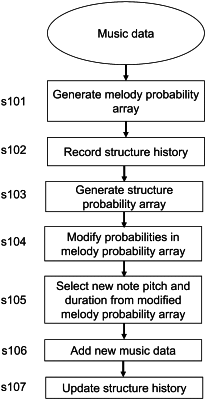| CPC G10H 1/0025 (2013.01) [G06N 7/01 (2023.01); G06N 20/00 (2019.01); G10H 1/0066 (2013.01); G10H 1/26 (2013.01)] | 17 Claims |

|
1. A computer-implemented method of generating a piece of music, the method comprising:
determining an initial sequence of notes for the piece of music;
determining at least one probability distribution for selecting at least one subsequent note from a set of candidate notes, wherein the at least one probability distribution is generated by a melody generator, and wherein the melody generator is trained to learn generation of sequences of notes in a musical way without consideration to an overall structure of the piece of music;
generating a structure probability array by a structure generator based on data of the initial sequence of notes, wherein the structure generator is trained to learn generation of a musical structure indicating similarity between sections of the piece of music; and
extending the initial sequence of notes with the at least one subsequent note selected from the set of candidate notes based on the at least one probability distribution and the structure probability array, wherein the structure probability array biases a selection of the at least one subsequent note to affect a likelihood of the selection resulting in a repeat of a musical element formed by the initial sequence of notes.
|